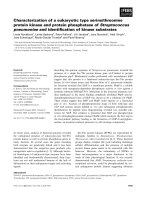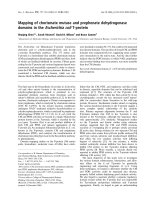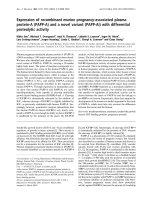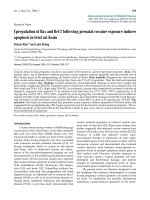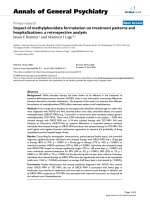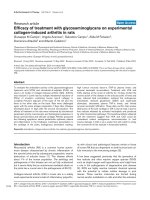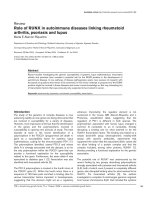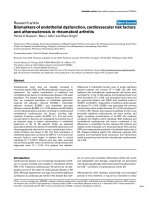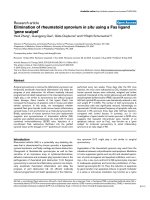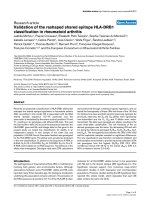Báo cáo y học: " Self-assembly of virus-like particles of porcine circovirus type 2 capsid protein expressed from Escherichia coli" pptx
Bạn đang xem bản rút gọn của tài liệu. Xem và tải ngay bản đầy đủ của tài liệu tại đây (337.82 KB, 5 trang )
RESEA R C H Open Access
Self-assembly of virus-like particles of porcine
circovirus type 2 capsid protein expressed
from Escherichia coli
Shuanghui Yin
†
, Shiqi Sun
†
, Shunli Yang, Youjun Shang, Xuepeng Cai
*
, Xiangtao Liu
*
Abstract
Background: Porcine circovirus 2 (PCV2) is a serious problem to the swine industry and can lead to significant
negative impacts on profitability of pork production. Syndrome associated with PCV2 is known as porcine
circovirus closely associated with post-weaning multisystemic wasting syndrome (PMWS). The capsid (Cap) protein
of PCV2 is a major candidate antigen for development of recombinant vaccine and serological diagnostic method.
The recombinant Cap protein has the ability to self-assemble into virus-like particles (VLPs) in vitro, it is particularly
opportunity to develop the PV2 VLPs vaccine in Escherichia coli,(E.coli ), because where the cost of the vaccine
must be weighed agains t the value of the vaccinated pig, when it was to extend use the VLPs vaccine of PCV2.
Results: In this report, a highly soluble Cap-tag protein expressed in E.coli was constructed with a p-SMK
expression vector with a fusion tag of small ubiquitin-like modifiers (SUMO). The recombinant Cap was purified
using Ni
2+
affinity resins, whereas the tag was used to remove the SUMO protease. Simultaneously, the whole
native Cap protein was able to self-assemble into VLPs in vitro when viewed under an electron microscope. The
Cap-like particles had a size and shape that resembled the authentic Cap. The result could also be applied in the
large-scale production of VLPs of PCV2 and could be used as a diagnostic anti gen or a potential VLP vaccine
against PCV2 infection in pigs.
Conclusion: we have, for the first time, utilized the SUMO fusion motif to successfully express the entire authentic
Cap protein of PCV2 in E. coli. After the cleavage of the fusion motif, the nCap protein has the ability to self-
assemble into VLPs, which can be used as as a potential vaccine to protect pigs from PCV2-infection.
Background
Porcine circoviruses (PCVs), classified as a member of
the family Circoviridae, are small icosahedral non-envel-
oped viruses (size ~17 nm) containing a circular single-
stranded DNA molecule of about 1.7 kb. Two genotypes
of PCV have been described. PCV1 was first isolated
and characterized as a persistent contaminant of the
PK-15 cell line and is considered as a non-pathogenic
virus [1]. PCV2 is an etiologic agent t hat is associated
with post-weaning multisystemic wasting syndrome
(PMWS) [2,3]. PMWS is currently considered to be an
important infectious swine viral disease that has a ser-
ious economic impact on t he pig farming industry.
Clinically, pigs affected with PMWS, frequently at 5 to
18 weeks of age, are characterized by pallor, progressive
weight loss, fever, difficulty in breathing, enlarged lymph
nodes, and, occasionally, diarrhea and jaundice. The
morbidity rate is usually low, but case fatality can be
more than 50% in affected herds [4].
The P CV2 genome contains two open r eading frames
(ORFs). ORF1 encodes the replicase (Rep and Rep’) pro-
teins located on the viral plus strands, which initiates
viral replication. ORF2 encodes the major structural
capsid (Cap) protein, which is a sole structural protein
of the viral coat [5] and also the major immunogenic
protein that works together with the princi pal carrier of
type-specific epitopes [6]. The Cap protein is highly
immunogenic and reacts strongly with the serum of
* Correspondence: ;
† Contributed equally
Lanzhou Veterinary Research Institute, Chinese Academy of Agricultural
Sciences, State Key Laboratory of Veterinary Etiological Biology, Key
Laboratory of Animal Virology of Ministry of Agriculture, Lanzhou 730046,
China
Yin et al. Virology Journal 2010, 7:166
/>© 2010 Yin et al; licensee BioMed Central Ltd. This is an Open Access article distributed under the terms of the Creative Commons
Attribution License ( which permits unrestricted use, distribution, and reproduction in
any medium, provided the original work is properly cited .
PCV2-infectedpigs.Therefore,itisagoodcandidate
antigen for the design of new recombinant vaccines
against PCV2 infection and for the development of sero-
logic tests. There are several PCV2 vaccines currently on
the market. The CIRCOVAC® (Merial Com, lyon,
France), which is an inactivated PCV2 vaccine. The vac-
cine of Suvaxyn PCV2 One Dose (Fort Dodge Animal
Health, Fort Dodge, IA) was the first PCV2 vaccine
approved for commercial use in the United States by
the United States Department of Agticulture. This vac-
cine is a chimeric virus that was developed to have the
PCV2 capsid and the PCV1genome. Another available
two vaccines are subunit vaccine, Ingelvac® CIRCOFLX™
(Boehringer Ingelheim Vermdedica Inc, St. jo seph, MO)
and Circumvent PCV (Intervet Inc, Millsboro, DE),
which are the capsid-based subunit vaccine expressed in
inactivated baculovirus. In recent years, two main
expression systems, including prokaryocytes and eukar-
yoc ytes, have been applied to express Cap protein as an
antigen for animal immunization against PCV2. The
prominent characteristic of the recombinant Cap protein
is its ability to independ ently self-assemble to form
virus-like particles (VLPs) in eukaryocytes, such as
insect-baculovirus and yeast expression systems [5,6].
However, few papers have reported on the production
of successful Cap protein VLPs in Escherichia coli
(E. coli) [7].
This is the first report on the production of Cap pro-
tein VLPs of PCV2 in E. coli. The small ubiquitin-like
modifier (SUMO) fusion expression system is used to
successfully express the whole native Cap (nCap) pro-
tein by making it highly soluble in E. coli.TheSUMO
tag is subjected to cleavage with SUMO protease. Simul-
taneously, the whole nCap protein s elf-assembles into
VLPs in vitro.
Materials and met hods
Construction of expression vectors with the fusion tag of
SUMO
The SUMO (Smt3) gene was amplified from Saccharo-
myces cerevisiae with primers Smt3F (5′-GCCATGG
(NcoI) GTCATCACCATCATCATCAC (6 × His) GGG-
TCGGACTCAGAAGTCAATCAA-3′)andSmt3R(5′-G-
GATCC (BamHI) GAGACC (BsaI) TTAAGGTCTC
( BsaI) AACCTCCAATCTGTTCGCGGTG-3′ ). A NcoI
restriction site followed bya6×Hiscodesequencewas
incorporated into the 5′ end of smt3. A 23-nucleotide
sequence containing BsaI on both positive and negative
strands and a BamHI restriction site were added to the 3′
end of smt3 gene. After double digestion with restriction
enzymes NcoI and BamHI, the amplified SUMO gene was
inserted into a pET-28a vector (Novagen) and digested
with the same enzymes. The resultant plasmid was desig-
nated a s pSMK (Fig. 1).
Cloning the Cap gene and construction of a recombinant
expression vector
A pair of expression primers of ORF2 was designed with
the PCV2 sequences in the Genbank database (accession
numbers FJ948168 and FJ948167). The full-length Cap
gene (702 bp, the genotype is PCV2b) of PCV2 was ampli-
fied, using PCR from recombinant complete PCV2 gen-
ome plasmid previously stored in our laboratory, with the
following primers: the upstream primer (CGT
GGT-
CTCCAGGTATGACGTATCCAAGGAGGCGT) con-
taining the BsaI site and the downstream primer
(TAT
CTCGAGTCAAGGGTTAAGTGGGGGGTCTTT)
containing the XhoI site. The PCR product was purified
and then digested with BsaI and XhoI (NEB), cloned into
p-SMK, a nd screened by transformants using re striction
enzyme analysis. The recombinant plasmid was designated
as p-SMK-Cap, whi ch was transformed into the host,
BL21-codon-Plus (DE3)-RIL strain (Stratagene).
Expression and purification of recombinant Cap protein
An overnight culture of E. coli cells in Luria-Bertani (LB)
medium (plus 34 μg/ml chloramphenicol and 80 μg/ml
kanamycin) containing recombinant p-SMK-Cap plasmid
was diluted 1:50 in 0.2 L fresh LB medium and incubated
at 37°C until cells reached mid-log growth. The remainder
of the culture was induced by the addition of isopropyl-b-
thiogalactopyranoside ( IPTG) to a final concentration of
0.1 mM and incubated further for 20 h at 20°C with shak-
ing at 180 rpm/min.
Cells were harvested by centrifugation at 5000 g for
15 min at 4°C. The cell pellet was resuspended in 50 ml
of 50 mM Tris-HCl buffer (1.0% Triton X-100, pH 8.0)
by stirring in an ice-cold water bath. The suspension
was disrupted on ice using ultrasonic cell crusher and
was centrifuged at 12000 g for 30 min at 4°C, and col-
lected using a 0.45 μm filter membrane, then equili-
brated with three columns of Tris-HCl buffer (20 mM
imidazole, 150 mM NaCl, pH 8.0) in a 70 ml column.
Figure 1 Scheme for the construction of the expression vector
p-SMK-Cap with SUMO motif.
Yin et al. Virology Journal 2010, 7:166
/>Page 2 of 5
The supernatant was transferred to the column and
incubated for 30 min at 4°C. Superfluous recombinant
proteins were washed with a T ris-HCl buffer (30 mM
imidazole, pH 8.0) until the protein indicator cannot
turn blue in a Bradford reagent (v/v: 5% of 95% ethanol,
10% of 88% phosphoric acid, and 0.07 mg/ml Coomassie
brilliant blue G-250). Bound protein was e luted with a
Tris-HCl buffer (300 mM imidazole, 150 mM NaCl, pH
8.0) until the protein indicator cannot turn blue. The
eluted production was concentrated at 4°C. Then, 2 ml
SUMO protease buffer (50 mM Tris-HCl, 0.2% Igepal,
1 mM DTT, pH 8.0) was added into the solution. The
quantity of the purified Cap-tag protein was obtained by
the Bradford assay (Sigma-Aldrich, USA) using bovine
serum albumin as a standard. It was analyzed through
15% SDS-PAGE and stored at 4°C for further assay.
Cleavage of a SUMO tag from a Cap-tag protein to yield
authentic VLPs of Cap
A cleavage reaction assay was performed containing 1 ×
SUMO protease buffer, 40 μl SUMO protease (1 unit/μl,
Invitrogen), 40 μg fusion protein, and water added to a
total volume of 400 μl, and incubated for 5 h at 16°C.
The cleavage reaction was diluted with 2 ml binding
buffer (50 mM Tris-HCl, 150 mM NaCl, pH 8.0), mixed
with 200 μl resins, and bound for 50 min using gentle
agitation to keep the resin suspended. T he supernatant
was transferred into an ultrafiltration tube and pro-
cessedat4°Cand2500gtoafinalvolumeof500μl.
The purified tagless nCap protein was identified through
15% SDS-PAGE. T he VLP preparations were dialyzed
against phosphate-buffered saline (PBS, pH 7.4) to a
final volume of 30 μl and further confirmed by electr on
microscopy.
Western blotting
Cap-tag and nCap, 30 μg respectively, which were trans-
ferred to an Immobilon-P transfer membrane (Millipore
Corporation, Bedford, MA, USA) in a transfer buffer
(20mMTris-HCl,190mMglycine,0.1%SDS,20%
methanol, pH 8.3) using a Mini-protean® tetra cell (Bio-
Rad, USA) at 0.8 mA/cm
2
for 2 h. The membranes were
blocked with 5% skim milk powder in PBST (PBS con-
taining 0.05% Tween 20) and incubated with anti-His
monoclonal antibody (mouse, 1:5000), (Sigma, USA) fol-
lowed by a peroxidase-conjugated anti-mouse antibody.
The DAB reagent was used to develop the signal
Transmission electron microscopy
For TEM studies, 25 μgofthenCapVLPswere
adsorbed onto a copper grid (200 mesh) for 2.5 min at
room temperature. Then, the grids were dried gently
using filter paper. After staining with 3% phosphotungs-
tic acid (PTA) for 2.5 min, the excess liquid was
removed, and the samples were viewed using a TEM
(Hitachi, H-7100FA) at an acceleration voltage of 75 kV.
The nCap VLPs were observed by immunoelectron
microscopy. Anti-PCV2 serum (1:100) from 60 day-old
PCV2-vaccinated pig, was reacted with nCap VLPs at
4°C overnight. The products were centrifuged at 3500 g
for 10 min. The pellet was dissolved in PBS. The pr e-
pared grid was stained by PTA and visualized by TEM.
Results
Expression, purification, and characterization of Cap
protein
ThewholeCapgenewasamplifiedbyPCRofPCV2
genomic DNA and cloned into p-SMK expressed vector
with the SUMO tag (5’-6 × His-SUMO-Cap-3’)(Fig.1).
The recombinant strains were induced at 20°C by IPTG.
The products were analyzed by SDS-PAGE. The Cap-
tag in E. coli is highly water-soluble. The supernatant of
cell lysis was purified on Ni
2+
affinity resins that have
the ability to specifically bind to His
6
-tag polypeptide.
ThepurityoftheCap-tagprotein is greater than 90%,
so it may be used as a template in the next protease
cleavage reaction (Fig. 2). The reaction of Cap-tag and
nCap may with anti-PCV2 pig sera and was observed by
Western blotting (Fig. 3).
Cleavage of His-Smt3 tag and assembly of Cap protein
VLPs
After the cleavage of the His-Smt3 tag with SUMO pro-
tease from the Cap-tag, the mixture was again passed
through Ni
2+
affinity resins. The cleaved His-Smt3 tag
and the SUMO protease bind to the column, whereas
nCap protein (about 26kDa) can be recovered in the
flow-through and observed by SDS-PAGE.
Figure 2 SDS-PAGE analysis of the Cap-ta g protein expression
in E. coli. Lane M, molecular weight marker; lane 1, bacterial lysates
from cells without IPTG; lane 2, bacterial lysates from IPTG-induced
cells in E. coli; lane 3, pellet from bacterial lysates; lane 4,
supernatant of bacterial lysates; lane 5, purified recombinant Cap-
tag protein.
Yin et al. Virology Journal 2010, 7:166
/>Page 3 of 5
Characterization of PCV2 nCap protein VLPs from E. coli
TEM and immunoelectron microscopy of the nCap pro-
tein show that it can assemble into Cap-like particles
with diameter ranging from 15 to 20 nm (Fig. 4A and
4B), and an a nti-PCV2 antibody that reacts with Cap
VLPs antigen to produce complexs(Fig. 4C). The results
suggest that the Cap protein expressed from E. coli
assembles into VLPs.
Discussion
It is usually dif ficult to express the whole Cap protein in
E. coli possi bly because of the specific amino acid at the
N terminus of a nuclear localization signal (NLS) [8]. In
whole Cap protein expression process, additional fusion
protein partners, such as glutathione S-transferase or
maltose binding protein, are able to achieve expression in
minute amounts [9,10]. Only the deletion of the whole
NLS domain may allow for the expression of a large
amount of the Cap protein. However, the NLS plays an
important role forming the self assembly of Cap-l ike par-
ticles and retains the antigenic function of the protein
[11]. The N terminus of the Cap protein of the NLS
domain is rich in arginine residues, which is a low-usage
codon in E. coli. Thus, by using codon optimization to
achieve Cap protein [12] and to overcome the difficulty
of expressing an authentic Cap protein and proceeding to
form VLPs in vitro, we recently constructed a SUMO
fusion protein expression system to produce the high-
level water-soluble Cap protein of PCV2 in E. coli.
Each prokaryocyte and eukaryocyte expressio n system
has advantages and limitations. In contrast, E. coli has
been a successful host for high expression levels of
many heterologous proteins because of its relative sim-
plicity, low cost, efficient generation time, and fast hig h-
density cultivation. Nevertheless, challenges need to be
overcome, such as proteolytic degradation of the target
protein, misfolding, formation of inclusion bodies, and
successful expression of soluble heterologous proteins.
Some fusion motifs or partners are frequently employ ed
to resolve the prob lems during the construction of
expression vectors in E. coli [13-15].
The SUMO fusion expression system offers advan-
tages over other fusion technologies, including improved
soluble expression, proper folding, protection from
degradation, and simplified purification and detection
[16]. To differentiate from other proteases that recog-
nize a peptide sequence and afte r cleaving, the fusion
tag can generate extraneous amino acids at the N termi-
nus of the target protein [17]. The SUMO protease
recognizes the tertiary structure of the SUMO tag, is
accurate and efficient for the generation of native
N-terminal amino acids, and does not result in extra-
neousresiduesattheNterminusofthetargetprotein
in recombinant proteins [16]. These demonstrate its
authentic traits.
VLPs mimic the structure of authentic virus particles
and present viral antigens in a more authentic confor-
mation and biological function. Therefore, they are
easily recognize d by th e immune system and able to sti-
mulate b oth B-cell and T-cell immune responses
[18-20]. In particular, many VLPs are non-in fectious
because, although they completely lack the viral DNA or
RNA genome, the y are safer than attenuated or chemi-
cally inactivated live viruses. This striking feature of
VLPs will likely contribute to the effectiveness of its use
in vaccination as a strategy for controlling diseases
[21-24].
Figure 3 Western blotting analysis of different Cap proteins
with anti-PCV2 pig sera. M, molecular weigh standard; Lane 1,
uninduced recombinant E. coli; lanes 2 and 3, nCap protein
cleavage of SUMO + 6 × His tag; lane 4, recombinant fusion Cap
protein with SUMO + 6 × His tag.
Figure 4 TEM images of recombinant Cap protein VPLs of PCV2. The recombinant Cap-tag protein (A) and Cap protein VPLs after cleavage
of the SUMO tag (B); immunoelectron microscopy image of the Cap protein VPLs (C). Scale bar is 50 nm.
Yin et al. Virology Journal 2010, 7:166
/>Page 4 of 5
Results of this research indicate that the VLPs of Cap
protein of PCV2 is successfully expressed in E. coli as
highly soluble substances. The study also shows that the
fusion tag is subjected to cleavage with the SUMO pro-
tease. Simultaneously, the whole Cap protein is a ble to
self-assemble into VLPs in vitro. TEM confirmed that
its shape and size are similar to Cap isolated from the
cell culture. The antigenic property of Cap protein VLPs
was confirmed by Western blotting and immunoelectron
microscopy.
Conclusions
In summary, we have, for the first time, utilized the
SUMO fusion motif to successfully express the entire
authentic Cap protein of PCV2 in E. coli. After the clea-
vage of the fusion motif, the nCap protein has the ability
to self-assemble into VLPs, whi ch can be used as a
potential VLPs vaccine to protectpigsfromPCV2-
infection.
Abbreviations
PCV2: porcine circovirus type 2; nCap: native capside; PMWS: post-weaning
multisystemic wasting syndrome; VLPs:virus-like particles; SUMO: small
ubiquitin-like modifier; PCR: polymerase chain reaction; DNA:
Deoxyribonucleic Acid; ORF: Open Reading Frame; TEM: transmission
electron microscopy; PTA: phosphtungstic acid.
Acknowledgements
This work was supported by a project from National Key Technology R&D
Program in the 11th Five year Plan of China (2006BAD06A12).
Authors’ contributions
SY focused on expression and purification of Cap protein, did do SDS-PAGE,
Western blotting and drafted the manuscript. SS conducted recombinant
expression vector with SUMO tag. SYg and YS contributed to the
interpretation of the findings and revised the manuscript, carried out TEM.
XC and XL edited the manuscript. All authors read and approved the final
manuscript.
Competing interests
The authors declare that they have no competing interests.
Received: 22 May 2010 Accepted: 21 July 2010 Published: 21 July 2010
References
1. Tischer I, Gelderblom H, Vettermann W, Koch MA: A very small porcine
virus with circular single-stranded DNA. Nature 1982, 295:64-66.
2. Allan GM, Ellis JA: Porcine circoviruses: a review. J Vet Diagn Invest 2000,
12:3-14.
3. Albina E, Truong C, Hutet E, Blanchard P, Cariolet R, L’Hospitalier R: An
experimental model for post-weaning multisystemic wasting syndrome
(PMWS) in growing piglets. J Comp Pathol 2001, 125:292-303.
4. Madec F, Eveno E, Morvan P, Hamon P, Blanchard P, Cariolet R: Post-
weaning multisystemic wasting syndrome (PMWS) in pigs in France:
clinical observations from follow-up studies on affected farms. Livestock
Prod Sci 2000, 63:223-33.
5. Nawagitgul P, Morozov I, Bolin SR, Harms PA, Sorden SD, Paul PS: Open
reading frame 2 of porcine circovirus type 2 encodes a major capsid
protein. J Gen Virol 2000, 81:2281-2287.
6. Fan H, Ju C, Tong T, Huang H, Lv J, Chen H: Immunogenicity of empty
capsids of porcine circovirus type 2 produced in insect cells. Vet Res
Commun 2007, 31:487-96.
7. Marcekova Z, Psikal I, Kosinova E, Benada O, Sebo P, Bumba L:
Heterologous expression of full-length capsid protein of porcine
circovirus 2 in Escherichia coli and its potential use for detection of
antibodies. J Virol Methods 2009, 162:133-141.
8. Wu PC, Chien MS, Tseng YY, Lin J, Lin WL, Yang CY, Huang C: Expression
of the porcine circovirus type 2 capsid protein subunits and application
to an indirect ELISA. J Biotechnol 2008, 133:58-64.
9. Liu Q, Tikoo SK, Babiuk LA: Nuclear localization of the ORF2 protein
encoded by porcine circovirus type 2. Virology 2001, 285:91-99.
10. Liu Q, Willson P, Attoh-Poku S, Babiuk LA: Bacterial expression of an
immunologically reactive PCV2 ORF2 fusion protein. Protein Expr Purif
2001, 21:115-120.
11. Zhou JY, Shang SB, Gong H, Chen QX, Wu JX, Shen HG, Chen TF, Guo JQ:
In vitro expression monoclonal antibody and bioactivity for capsid
protein of porcine circovirus type II without nuclear localization signal. J
Biotechnol 2005, 118:201-211.
12. Trundova M, Celer V: Expression of porcine circovirus 2 ORF2 gene
requires codon optimized E. coli cells. Virus Genes 2007, 34:199-204.
13. Pryor KD, Leiting B: High-level expression of soluble protein in Escherichia
coli using a His6-tag and maltose-binding-protein double-affinity fusion
system. Protein Expr Purif 1997,
10:309-319.
14. De Marco V, Stier G, Blandin S, de Marco A: The solubility and stability of
recombinant proteins are increased by their fusion to NusA. Biochem
Biophys Res Commun 2004, 322:766-771.
15. Wang C, Castro AF, Wilkes DM, Altenberg GA: Expression and purification
of the Wrst nucleotide-binding domain and linker region of human
multidrug resistance gene product: comparison of fusions to glutathione
S-transferase, thioredoxin and maltose-binding protein. Biochem J 2007,
338:77-81.
16. Butt TR, Edavettal SC, Hall JP, Mattern MR: SUMO fusion technology for
difficult-to-express proteins. Protein Expr Purif 2005, 43:1-9.
17. Schaefer F, Schaefer A, Steinert K: A highly specific system for efficient
removal of tags from recombinant proteins. J Biomol Tech 2002,
13:158-171.
18. Murata K: Immunization with hepatitis C virus-like particles protects mice
from recombinant hepatitis C virus-vaccinia infection. Proc Natl Acad Sci
USA 2003, 100:6753-6758.
19. Paliard X: Priming of strong broad, and long-lived HIV type 1 p55gag-
specific CD8þ cytotoxic T cells after administration of a virus-like particle
vaccine in rhesus macaques. AIDS Res. Hum. Retroviruses 2000,
16:273-282.
20. Schirmbeck R: Virus-like particles induce MHC class I-restricted T-cell
responses. Lessons learned from the hepatitis B small surface antigen.
Intervirology 1996, 39:111-119.
21. Antonis AFG, Bruschke CJM, Rueda P, Maranga L, Casal JI, Vela C, Hilgers LA,
Belt PBGM, Weerdmeester K, Carrondo MJT, Langeveld JPM: A novel
recombinant virus-like particle vaccine for prevention of porcine
parvovirus-induced reproductive failure. Vaccine 2006, 24:5481-5490.
22. Grgacic EVL, Anderson DA: Virus-like particles: passport to immune
recognition. Methods 2006, 40:60-65.
23. Lenz P, Day PM, Pang YY, Frye SA, Jensen PN, Lowy DR, Schiller JT:
Papillomavirus-like particles induce acute activation of dendritic cells. J
Immunol 2001, 166:5346-5355.
24. Li TC, Takeda N, Miyamura T, Matsuura Y, Wang JCY, Engvall H, Hammar L,
Xing L, Cheng RH: Essential elements of the capsid protein for self-
assembly into empty virus-like particles of hepatitis E virus. J Virol 2005,
20:12999-13006.
doi:10.1186/1743-422X-7-166
Cite this article as: Yin et al.: Self-assembly of virus-like particles of
porcine circovirus type 2 capsid protein expressed from Escherichia coli.
Virology Journal 2010 7:166.
Yin et al. Virology Journal 2010, 7:166
/>Page 5 of 5
